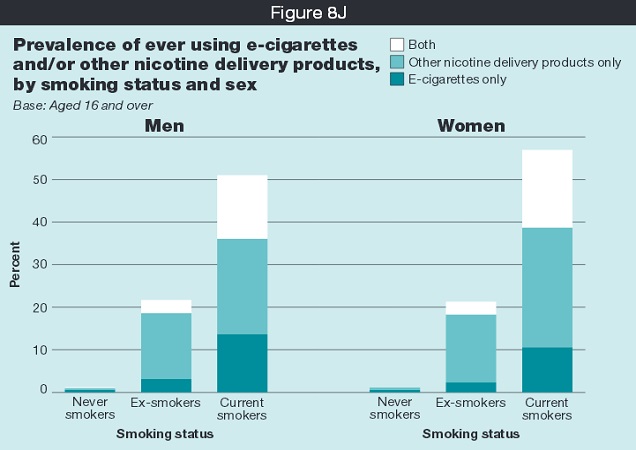
There’s been quite a lot of research out recently on the issue of non-smokers (ordinarily children and teens, but adult non-smokers are a concern too) taking up vaping, with loud and widely-publicized concern being undermined by thoroughly non-concerning data. In December, the 2013 Health Survey for England was released, and this adds more evidence that non-smokers – children or adults – are not particularly interested in e-cigarettes and their use is confined almost entirely to smokers or ex-smokers. Yet again, the idea of a potential gateway to smoking has been slapped down by cold, hard facts.
The Health Survey for England – Investigating Smoking and Vaping
As one of its numerous areas of focus, the NHS-conducted Health Survey for England asks questions to its participants about their smoking habits and the use of e-cigarettes. The 2013 survey covered around 8,800 participants aged 16 and over, as well as around 2,200 children aged 8 to 15 (although only 13 to 15 year olds were asked about vaping). This was the first year questions were asked about e-cigarettes, and the findings are given (primarily) in the adult smoking results, although there is some limited discussion in the child smoking document.
What They Found – Vaping in Non-Smokers is Extremely Rare
The core finding related to e-cigarettes was that 3 percent of the whole adult sample currently used e-cigarette users, generally being more common in people aged between 25 and 54. Further analysis showed that 29 percent of smokers had ever used e-cigarettes, compared to 6 percent of ex-smokers. For never-smoking men, around one percent had ever tried vaping, and the corresponding figure for women was less than one percent.

The use of deadly combustible cigarettes is still much higher than the use of e-cigarettes, with 24 percent of men currently smoking and 17 percent of women doing so. For women, this figure has decreased notably in recent years, going from 24 percent in 2003 to 19 percent in 2012 and even lower in 2013. Many recent population-level studies have shown a corresponding decrease in smoking as vaping becomes more popular, but in this case the decline for women was underway prior to e-cigs becoming popular and for men recent rates have been stable. Men generally smoke more cigarettes per day than women.
The figures for children’s use of e-cigarettes aren’t provided in the document, because despite the large sample size, the resulting numbers of users are so small that results weren’t even provided in the paper. According to the write-up, “only very small numbers” reported current or past use of non-tobacco products, with nicotine gum and e-cigarettes being the most common.
With no hard figures to go on, it’s hard to add much more than that, but the survey authors still see the necessity to add that “some” of the children who’d ever vaped reported that they’d never smoked. Of course, large numbers of non-smoking kids doing this might be an issue (if you knew they wouldn’t have smoked a cigarette otherwise), but “some” doing it is hardly something to be concerned about. As with every other piece of research done into this issue, the study shows that never-smoking kids really aren’t interested in vaping, although a small percentage appears to try them out at least once.
For cigarettes, there are easily enough users aged 8 to 15 from this sample to report actual data: with 8 percent of boys and 7 percent of girls having ever smoked (mainly 14 and 15 year olds). For 13 to 15 year olds, regular smoking rates (of anything from one to over six cigarettes per week) range from around 1 to 4 percent for boys and 0.6 to 6 percent for girls. It’s clear that e-cigarette use rates must be considerably lower than this, so any concern about youth usage seems to be misguided, to say the least.
ASH UK’s Deborah Arnott commented, “While it is clearly important to continue to monitor smoking rates and the use of electronic cigarettes in adults and children, so far there is no evidence that use of electronic cigarettes is proving to be a gateway into smoking.”
And that’s pretty much what it all comes down to. Of course we need to make sure e-cigarettes aren’t luring children into a lifetime of smoking and putting them at risk of a plethora of health conditions, but it’s frankly absurd to go around claiming that e-cigarettes are a gateway to tobacco (as many anti-smoking groups are) when the evidence demonstrates nothing of the sort. There may be the odd, superficially-worrying finding, but the vast majority wrongly labels past-month experimentation as current use and sometimes just focuses on ever use rates instead of anything even resembling current use.
When you look at the evidence rationally, digging through the findings to turn up the rates of current use among never-smokers, the “cause for concern” being touted by many appears thoroughly ridiculous. More importantly, the studies to date which have actually addressed the true gateway issue have found no evidence whatsoever to support it.
Conclusion – More Vapers = More Lives Saved

So the choice politicians and public health experts are apparently struggling with is: do the (unproven) risks of a gateway to tobacco outweigh the potential benefits of e-cigarettes on society? Does the (incredibly unlikely) possibility that our short-term and chemical evidence to date is completely wrong and e-cigs really are dangerous make it worth discouraging smokers from switching to what appears to be a vastly safer habit? If you want to save lives, the issue is a simple one – e-cigs are vastly safer than combusted tobacco and primarily appeal to smokers (adult or youth), so we need as many smokers as possible to be using them. The public health community and anti-smoking groups should realistically be doing even more than vapers do to ensure the continued availability of e-cigs, because more vapers means more lives saved. Obviously, they just aren’t all that interested in saving lives.

